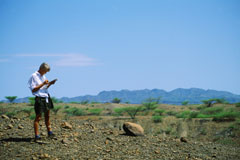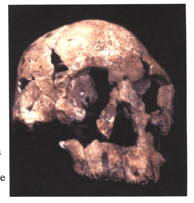K. platyops and K. rudolfensis
| K. platyops |
| K. rudolphensis |
______________________________________________________________________________
In 1998, Meave Leakey and her team discovered
a nearly complete
skull and jawbone fossils dating between
3.5 and 3.2 million years
ago in Lomekwi, Kenya (west of Lake Turkana).
Its brain size is
similar to Australopithecus.
The age of this fossil is contemporaneous
with Lucy, or A. afarensis, but its morphology is
very different. K. platyops skull is
characterized by small molar teeth, and a tall flat face.
Platyops literally means "flat face."
Lucy had protruding faces and large teeth.
 Studying teeth and jaw bones can reveal something about the diet of
these early
Studying teeth and jaw bones can reveal something about the diet of
these early
hominids. The different morphologies suggest
it is possible that K. platyops and A.
afarensis cohabited Kenya without
competing for food resources.
Following the same logic applied to O.tungensis, Meave Leakey argues that K. platyops may be a better link to the Homo genus than Lucy.
Two lineages cohabiting Kenya
at this date must have resulted from earlier hominid diversity
(before 2.5 mya). This find strengthens
the argument for adaptive radiation evolutionary
hypothesis and against linear evolution. When
considering the evolution of other mammals,
there are normally many adaptive radiations
and only a few species survive. Therefore, such
early hominid diversity should not be a surprise.
The lines of the family tree may be better
redrawn to resemble a bush instead of a tree.
LINKS:
Our Earliest Ancestor: K platyops
A New Face Added to Humankind's Family Tree (National Geographic)
Origins of Humankind (PBS)
The Flat Faced Man of Kenya (Nature)
Leaving Lucy in the Dust

Appearing 2.5 to 1.9 million years ago overlapping much of Homo habilis' existence, K. rudolfensis' browridges were less prominent than the australopithecus genus. The face is more prognathic, and the snout is less protruding. There is no sagittal crest; the large zygomatics, as in P. robustus and P. boisei, have disappeared. The molars, canines, and incisors are increasingly closer to the same size. The skull bones were thinner and generally more delicate. The average cranial capacity is 750 cc. Its body weight was approximately 50 kg, and the species was probably sexually dimorphic. Although none of its remains are associated with stone tools, its large brain indicates that it possibly manufactured tools of the early Oldowan tool industry. In many respects, K. rudolfensis was a little more advanced than Homo habilis . This could suggest that Homo habilis was a dead end, while Kenyanthropus rudolfensis gave rise to Homo erectus and all later human species.
Kenyanthropus rudolfensis has caused paleoanthropologists to alter their views of human origins. There are many questions raised by its naming, which include its relationship to the australopithecines and Homo habilis, questions that cannot be answered based on such scant fossil evidence. Until new finds are made, these questions remain a mystery.
Links:
Human Ansector Hall
Evolution: Origins of Humans (PBS)
A New Face in Human Evolution